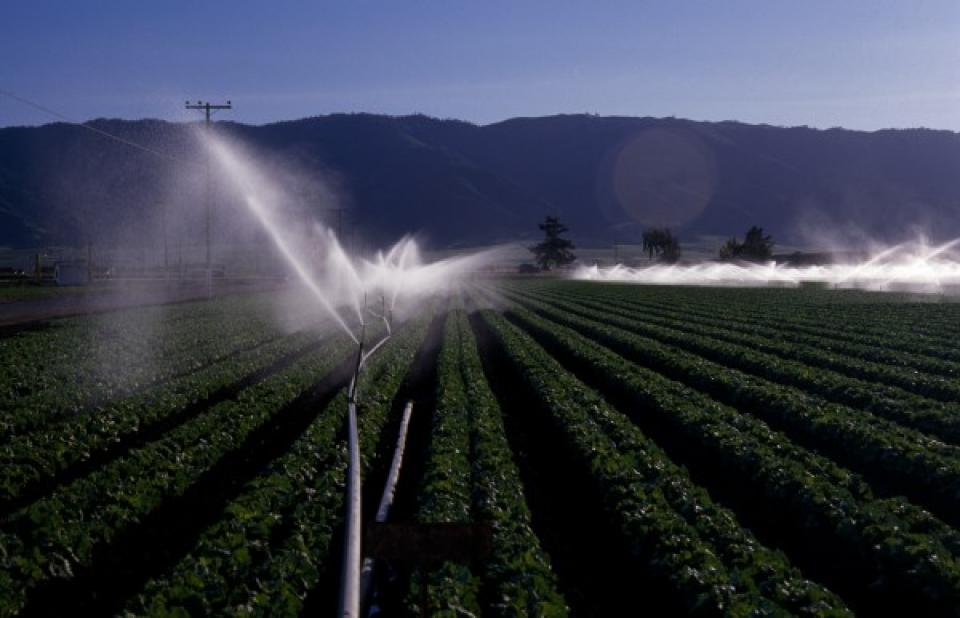Agricultural Drainage
California’s rich agricultural productivity comes with a price. The dry climate that provides the almost year-round growing season also can require heavily irrigated soils. But such irrigation can degrade the local water quality.
Two of the state’s most productive farming areas in particular, the west side of the San Joaquin Valley and parts of the Imperial Valley in Southern California, have poorly drained and naturally saline soils.
If a field is not adequately drained, the ground then becomes waterlogged, as it does on the west side of the San Joaquin Valley. At the same time, salts from the irrigated soil can accumulate in the shallow groundwater. To remedy this, underground drainage pipes allow farmers to flush excess salts from the soil.
However, the saline water from these pipes, must also go somewhere, creating one of the most difficult issues facing California’s agricultural industry—agricultural drainage.
Agricultural Drainage Overview
If the soil retains too much water, manmade methods for draining excess water from the root zone of plants are often used. Manmade drainage also may be necessary if the farmer’s soil or water supply contains elements harmful to the crop. Additional water is then added to leach these elements from the root zone.
The amount of water required for adequate leaching varies widely with the salinity of the soil and irrigation water, the salt tolerance of the crop, the uniformity of the field slope and other factors.
However, if a soil drains freely, and the groundwater table is not saturated, the excess salts and water percolate deep underground. This percolation can increase contamination of groundwater aquifers.
Additionally, in some basins, rivers are used to transport salts from agricultural lands. Thus, drainage becomes part of the flow of the river and is carried to the ocean or an inland sink such as the Salton Sea in the Imperial Valley. A prime concern in these basins is whether salinity in the river can be kept below levels that may harm downstream uses of the water, or fish and wildlife.
In other areas where no outlet to rivers is available, such as the Tulare Lake Basin, drainage water is carried to evaporation ponds. Drainage water is the only source of water in many of these ponds, resulting in extremely high concentrations of salts. Concentrations of other trace elements such as selenium are also elevated in evaporation basins, with a wide degree of variability among basins. On the west side of the San Joaquin Valley in the Central Valley Project service area one controversial proposal was to construct the San Luis Drain to funnel drainage water to the Sacramento-San Joaquin Delta.
Although selenium in trace amounts is essential to all human and animal life, it has long been known to be harmful and even lethal at elevated concentrations. Fish and wildlife may become exposed to harmful concentrations of the element through bioconcentration and biomagnification.
Coping With Drainage Water
Throughout parts of the Imperial, Coachella, Sacramento and the western San Joaquin valleys, districts were established to deliver water to arid agricultural lands and to construct, operate and maintain regional drainage systems. These systems collect drainage water from individual farms and convey the water to a point of reuse, disposal or dilution.
On-farm drainage management is the responsibility of the individual landowner. Most farms have some kind of surface drainage system and some have subsurface drainage systems.
Once laid, subsurface drain lines are not problem-free. They can be blocked or damaged by roots, soil, farming equipment, earthquakes, subsidence and buildup of minerals such as iron.
Addressing Agricultural Drainage
After years of identifying the causes of the drainage problem, practical solutions are underway to handle drainage disposal.
Significant new information also has been developed over the past decade regarding the design and operation of evaporation basins as a major Central Valley method of drainage water disposal. Also, on-farm efforts to reduce the amount of drainage water and even reuse it have been successful.
Possible Agricultural Drainage Solutions
Agricultural drainage solutions can include:
- Source control: on-farm improvements in irrigation to reduce the amount of applied water, therefore reducing drainage water.
- Drainage reuse: reusing drainage water to irrigate increasingly salt-tolerant plants such as cotton, eucalyptus, forage crops, etc.
- Evaporation systems: disposing of residual drainage water in evaporation ponds.
- Land retirement: fallowing farmland that overlies difficult-to-drain, shallow groundwater containing high levels of selenium— controversial and complex issue.
- Protection, restoration and water supplies for fish and wildlife habitat: providing fresh water to substitute for drainage-contaminated supplies, protecting and restoring contaminated fisheries and wildlife habitat.









